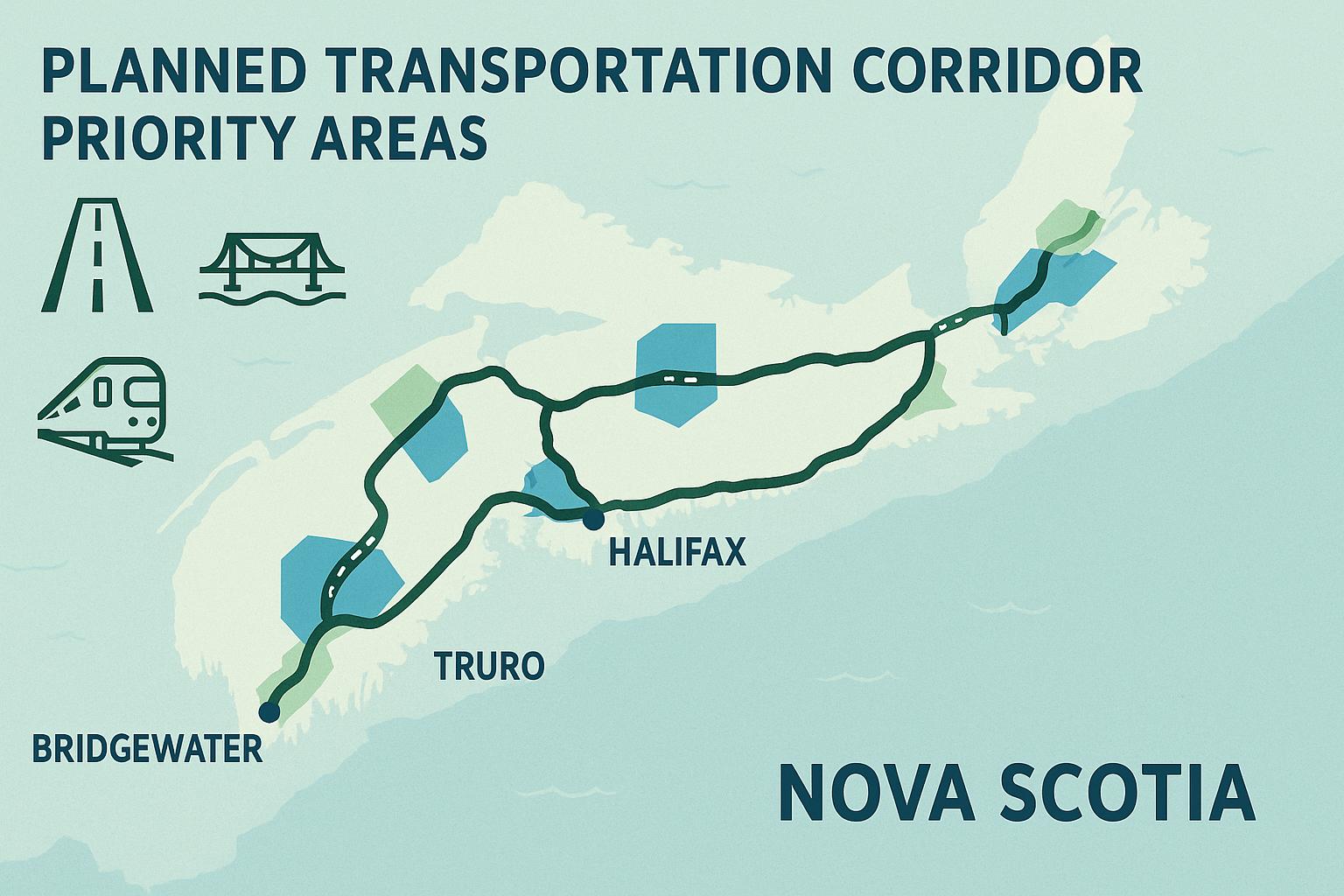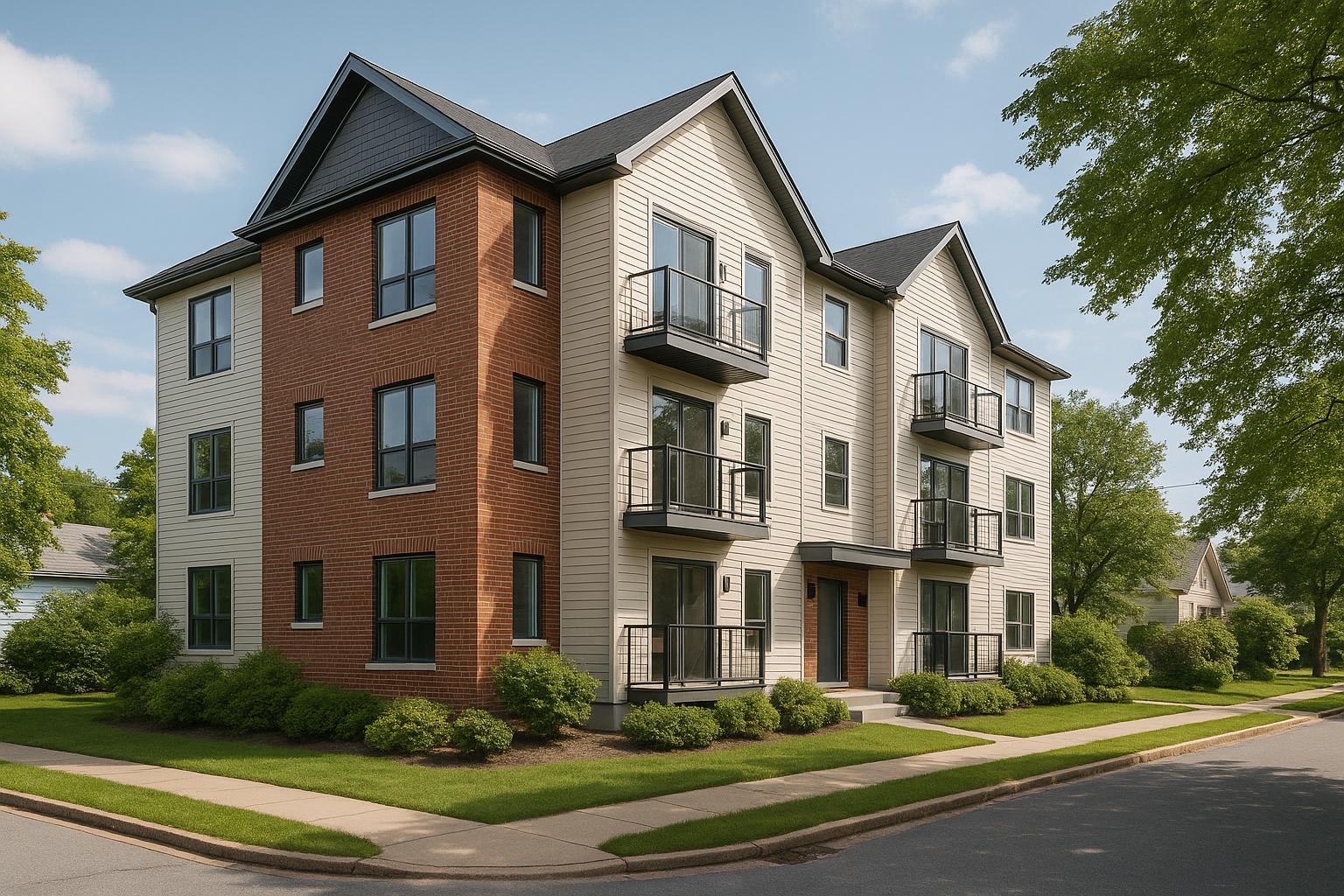Building a home in Nova Scotia? Here's what you need to know about construction financing:
- Construction loans release funds in stages (draws) as your project progresses. Interest is only charged on the amount withdrawn.
- Down payments typically range from 25–30% of the total project cost, and most lenders cover up to 75% of building costs.
- Loan terms are usually one year, with slightly higher interest rates than traditional mortgages. After construction, the loan transitions into a regular mortgage.
- You’ll need detailed plans, cost estimates, and a licensed builder to secure approval.
- Expect costs like inspection fees, permit charges, and construction insurance. Interest rates often start at 9.99% annually.
Planning ahead with a contingency fund (10–15% of your budget) and working with experienced professionals can help you manage costs and avoid delays. Once construction is complete, your loan converts into a standard mortgage with regular payments.
For more details on financing types, grants, and cost planning, read on.
Construction Financing Process Explained | How Construction ...
Construction Loan Basics
Let's dive deeper into how construction loans work in Nova Scotia, focusing on how funds are released and projects are monitored.
Construction loans provide funding for new builds through a series of staged payments, known as "draws."
Payment Stages and Draws
Funds are disbursed at specific construction milestones, with percentages tied to each stage of completion:
- Foundation (15% complete): 15% of the loan
- Weather‑protected structure (40%): 25%
- Interior systems (65%): 25%
- Interior finishing (85%): 20%
- Project completion (100%): 15%
Before each draw is approved, an inspector reviews the progress to ensure the work meets the required standards. Borrowers are typically responsible for inspection fees, although some lenders may deduct these costs from the draw amount [1].
Loan Terms and Rates
Construction loans usually come with higher interest rates compared to traditional mortgages. Borrowers only pay interest on the funds that have been disbursed. Most lenders cover up to 75% of the total building costs, requiring a 25% down payment and a minimum credit score of 680 [4].
Project Oversight
To safeguard their investment, lenders require detailed progress reports and inspections before releasing funds at each stage. Inspectors or appraisers assess the quality and completion of work, often providing reports and photographic evidence. Working with a licensed builder who has a solid track record can help ensure smooth and timely fund releases.
Next, we’ll look into financing options for building personal homes and investment properties.
Financing Types by Builder
When deciding on financing, the approach will vary depending on whether you're constructing a personal home or an investment property.
Personal Home Construction
For personal home builds, self-build mortgages are a common choice. These loans release funds in stages, known as draws, which align with key construction milestones like excavation, framing, and finishing. Borrowers are responsible for paying for inspections before each draw. Typically, lenders require 25–35% equity and charge interest only on the funds that have been drawn. Due to the risks associated with construction, approval criteria can be stricter [1][2].
Multi-Unit Project Funding
For projects like duplexes or fourplexes, residential construction mortgages may take projected rental income into account during the qualification process. However, if your project exceeds four units, you'll likely need commercial financing. This often involves programs like CMHC's Mortgage Loan Insurance (MLI) Select program. To secure this type of funding, you'll need to provide detailed pro forma rent rolls and building specifications.
Nova Scotia Lending Programs
In Nova Scotia, the Secondary and Backyard Suite Incentive program from Housing Nova Scotia offers forgivable loans of up to $40,000 for secondary-suite projects. To qualify, you must show proof of equity or secured financing to cover the remaining costs [5].
Available Grants and Rebates
In addition to loans, builders can take advantage of various government rebates and incentives to help reduce costs.
Federal Support Programs
The federal New Housing Rebate allows builders to recover a portion of the GST/HST paid on new builds. First-time builders might also qualify for additional benefits. For the latest eligibility requirements, visit the Canada Revenue Agency and Government of Canada websites.
Nova Scotia Programs
Nova Scotia, along with Housing Nova Scotia, provides several options like rebates, loans, and forgivable incentives aimed at energy-efficient and affordable housing. These include energy efficiency rebates, down payment assistance, and incentives specifically for rural or multi-unit developments. Each program has its own income thresholds, property eligibility, and deadlines. For more information, check the Nova Scotia government website.
sbb-itb-16b8a48
Cost Planning
Plan for essential construction costs in Nova Scotia.
Monthly Costs
During construction, you'll generally pay interest only on the funds you've used. As construction progresses and you draw more money, your monthly interest costs will rise. Construction loan rates often begin at around 9.99% annually [3].
Here are some key expenses to consider:
- Interest payments: 9.99% annual rate on drawn amounts (calculated monthly)
- Inspection and draw fees: Vary by lender and are deducted per draw
- Permit fees: One-time municipal charges
- Construction insurance: Annual course-of-construction premium
In Halifax, construction costs range from $120 to $180 per square foot. For example, building a 1,530-square-foot home could cost between $183,600 and $275,400 [2].
It's also a good idea to set aside an emergency fund to handle unexpected costs.
Emergency Fund Planning
Material price fluctuations and delays caused by weather can lead to unexpected expenses. Many lenders require you to have contingency reserves in place to cover these types of overruns [3]. Check with your lender to confirm the required reserve amount and consider keeping extra funds for added peace of mind.
Track all expenses carefully and compare them against your budget regularly. This will help you catch potential overruns early and adjust your plan if necessary.
Mortgage Conversion Steps
Once you've accounted for interest, fees, and contingency funds, it's time to prepare for converting your loan into a mortgage. With your contingency reserves in place and construction complete, the next step is securing permanent financing.
To switch your construction loan to a permanent mortgage, you'll need to meet your lender's requirements and obtain final approval. These typically include:
- A final property appraisal to confirm the completed value of your home.
- A certificate of occupancy to verify the property complies with building codes and is safe for living.
- Proof of completed work to ensure all contracted tasks are finished.
After approval, your payments will shift from interest-only draws to regular payments covering both principal and interest. Most lenders expect 20–25% equity, often satisfied by your initial down payment [1]. Collaborating with a mortgage broker or lender familiar with construction mortgages can help simplify the process and avoid unnecessary delays [1].
Success Strategies
Once your construction loan is secured and converted, it's important to focus on keeping your project running smoothly and staying within budget. Here are some practical tips to help you manage your project effectively.
Bank Relations
Work with a single point of contact at your lender to streamline the process for draw approvals and documentation. Assigning a dedicated loan specialist to handle the paperwork and draw requests can save time and reduce confusion.
Credit Management
Construction loans often come with higher risks, so maintaining a strong credit profile is crucial [1][6]. To safeguard your credit:
- Pay bills on time and keep your credit balances low.
- Avoid applying for new credit during the project.
It’s also wise to set aside a contingency fund. This can help cover unexpected expenses without the need to take on more credit [6].
Builder Selection
Pick a builder who is licensed, insured, and experienced in projects similar to yours. Make sure they are familiar with your loan's draw schedules and inspection requirements. This ensures a smoother process and helps keep your financing on track.
Conclusion
Securing construction financing in Nova Scotia requires thoughtful preparation. Aim for a credit score of 680 or higher and set aside a 10–15% contingency fund to improve your chances of approval [4].
Before applying, ensure you have detailed construction plans, a clear project timeline, a comprehensive cost breakdown, and up-to-date financial statements [4]. Working with an experienced builder can also make a difference. For example, Helio offers fixed-price contracts starting at $168 per square foot, giving lenders the cost certainty they often look for.
With the right preparation and a reliable partner, building your dream project in Nova Scotia is possible. Get in touch with us to explore your budget and financing options!
Related posts
- Bridging Finance in Halifax, Nova Scotia: How to Secure Interim Funding for Your New Build Project
- Tax Rules for Construction Loan Interest in Nova Scotia
- Financing Your Small Multi-Unit Build in Nova Scotia: Options & Strategies
- The Nova Scotia Home Build Blueprint: Step-by-Step Guide from Planning to Move-In



